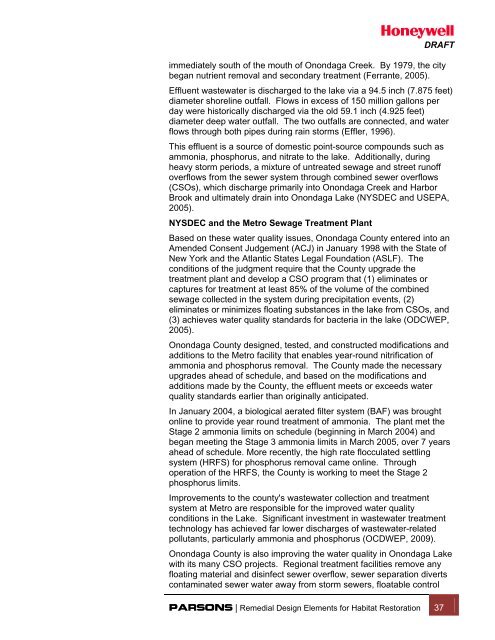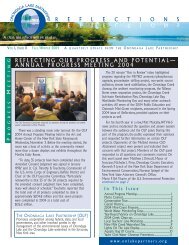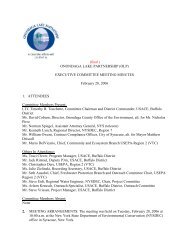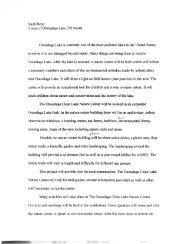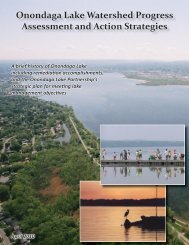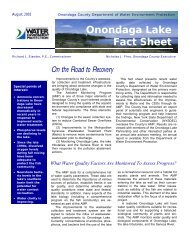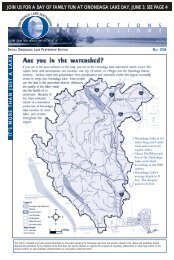Habitat Plan 2 - Onondaga Lake Partnership
Habitat Plan 2 - Onondaga Lake Partnership
Habitat Plan 2 - Onondaga Lake Partnership
You also want an ePaper? Increase the reach of your titles
YUMPU automatically turns print PDFs into web optimized ePapers that Google loves.
DRAFTimmediately south of the mouth of <strong>Onondaga</strong> Creek. By 1979, the citybegan nutrient removal and secondary treatment (Ferrante, 2005).Effluent wastewater is discharged to the lake via a 94.5 inch (7.875 feet)diameter shoreline outfall. Flows in excess of 150 million gallons perday were historically discharged via the old 59.1 inch (4.925 feet)diameter deep water outfall. The two outfalls are connected, and waterflows through both pipes during rain storms (Effler, 1996).This effluent is a source of domestic point-source compounds such asammonia, phosphorus, and nitrate to the lake. Additionally, duringheavy storm periods, a mixture of untreated sewage and street runoffoverflows from the sewer system through combined sewer overflows(CSOs), which discharge primarily into <strong>Onondaga</strong> Creek and HarborBrook and ultimately drain into <strong>Onondaga</strong> <strong>Lake</strong> (NYSDEC and USEPA,2005).NYSDEC and the Metro Sewage Treatment <strong>Plan</strong>tBased on these water quality issues, <strong>Onondaga</strong> County entered into anAmended Consent Judgement (ACJ) in January 1998 with the State ofNew York and the Atlantic States Legal Foundation (ASLF). Theconditions of the judgment require that the County upgrade thetreatment plant and develop a CSO program that (1) eliminates orcaptures for treatment at least 85% of the volume of the combinedsewage collected in the system during precipitation events, (2)eliminates or minimizes floating substances in the lake from CSOs, and(3) achieves water quality standards for bacteria in the lake (ODCWEP,2005).<strong>Onondaga</strong> County designed, tested, and constructed modifications andadditions to the Metro facility that enables year-round nitrification ofammonia and phosphorus removal. The County made the necessaryupgrades ahead of schedule, and based on the modifications andadditions made by the County, the effluent meets or exceeds waterquality standards earlier than originally anticipated.In January 2004, a biological aerated filter system (BAF) was broughtonline to provide year round treatment of ammonia. The plant met theStage 2 ammonia limits on schedule (beginning in March 2004) andbegan meeting the Stage 3 ammonia limits in March 2005, over 7 yearsahead of schedule. More recently, the high rate flocculated settlingsystem (HRFS) for phosphorus removal came online. Throughoperation of the HRFS, the County is working to meet the Stage 2phosphorus limits.Improvements to the county's wastewater collection and treatmentsystem at Metro are responsible for the improved water qualityconditions in the <strong>Lake</strong>. Significant investment in wastewater treatmenttechnology has achieved far lower discharges of wastewater-relatedpollutants, particularly ammonia and phosphorus (OCDWEP, 2009).<strong>Onondaga</strong> County is also improving the water quality in <strong>Onondaga</strong> <strong>Lake</strong>with its many CSO projects. Regional treatment facilities remove anyfloating material and disinfect sewer overflow, sewer separation divertscontaminated sewer water away from storm sewers, floatable controlPARSONS | Remedial Design Elements for <strong>Habitat</strong> Restoration 37


